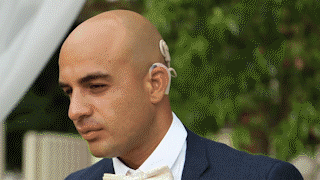Life-changing medical innovations that make the impossible possible (Sponsored)
Editor's note: This sponsored article was commissioned by Sandvik.
When you see an elite athlete with a prosthetic limb cross the finish line or witness a heartwarming video of an infant hearing for the first time thanks to a cochlear implant, it's easy to feel the miracle and forget the precision required to make such advanced medical devices.
For global engineering firm Sandvik, that precision is a way of life. The firm makes the machining tools and components — such as medical wire a mere tenth of a millimeter in diameter — that make the impossible possible.
Impossible like: A pro snowmobile racer who lost his leg in a racing accident and who now manufactures his own cutting-edge prosthetics using Sandvik technology in order to keep competing in the sport he loves.
Impossible like: A new father whose symptoms of early-onset Parkinson's disease are quelled by electrodes delicately entwined with his brain tissue.
Impossible like: A teenager with type 1 diabetes released from the constant needlesticks of glucose monitoring by a tiny sensor that remains on her arm 24/7.
Sandvik's medical tools and components are a crucial part of helping people with chronic conditions and disabilities live life to its fullest potential.
A multisport athlete
Pro snowmobiler "Monster" Mike Schultz was one of the top five snowcross racers in the world in 2008 when he got bucked off his snowmobile during a qualifying race in 2008. His knee hyperextended, destroying the tissue. A snowstorm delayed his arrival at the hospital, compounding the damage. Ultimately, Schultz's leg had to be amputated.
Schultz quickly got a prosthetic limb and was soon up and about, but the prosthetic wasn't suitable for his previous competitive lifestyle.
"I didn't want to race if I couldn't compete at the level I did before," he said. "I kind of wrote it off."
When he heard about the X Games Supercross Adaptive sports competition, though, he knew he'd found a place where he could pit himself against athletes of his own caliber. But he needed a prosthesis that would work for snowmobiling, and there was no such thing. So he invented his own.
Sandvik's precision-machining tools make this sort of manufacturing possible; a prosthesis like Schultz's needs to be both strong and supple, and materials that are both require specialized tools to shape. By applying Sandvik's tools and his own ingenuity, Schultz has not only created prosthesis that have helped him take home 10 gold medals in the X Games and a gold and a silver at the 2018 Winter Paralympics, he's started his own company, BioDapt, which markets an adjustable knee for moto sports and a prosthetic sports foot.
Wires that bind
As a global engineering firm that serves multiple industries, from mining to medical, Sandvik is a go-to source for the kind of delicate components that can interface with human tissue.
One example is Sandvik's EXERA fine medical wire, which is as fine as human hair and delicate enough to be used in neurological devices. One beneficiary of this technology is Andrew Johnson, a New Zealand father who at the age of 35 started to experience tiny tremors in one hand. The diagnosis? Early-onset Parkinson's disease. Parkinson's is a disorder of the central nervous system in which levels of the neurotransmitter dopamine drop precipitously, leading to difficulty with movement, balance and coordination.
As Johnson's disease progressed, he struggled with periods of involuntary movement and with moments where he could not move at all. Two years after diagnosis, he was approved for deep brain stimulation, which involves implanting electrodes into the brain region that controls movement. A wisp-thin wire attached to these electrodes runs through the body to an implanted neurostimulator that regulates the brain activity disrupted by Parkinson's. The wire that makes this possible is Sandvik's EXERA fine medical wire, which is coated with specialized dielectric materials (or electrical insulators) so that they don't short-circuit one another or deliver signals to the incorrect location. For Johnson, the surgery has been life-changing, allowing him to participate in family life as a stay-at-home father.
A guardian of glucose
The same medical wire also enables people with diabetes to monitor their glucose levels without repetitive needle sticks — a particular boon for the youngest type 1 diabetes patients. Amanda Rosengren was diagnosed with the disease at age 4 and had to sit through multiple needle pricks each day so that her parents could monitor her blood sugar. In 2013, the Rosengren family learned of the possibility of getting a continuous glucose monitor (CGM) for Amanda. This device uses a minuscule sensor made, in part, with EXERA fine medical wire to detect the glucose found in the interstitial fluid between cells. The sensor sends an electrical signal to a transmitter and external monitor. The data automatically uploads into an app on Amanda's cellphone.
"Usually, these types of wire are more commonly found in consumer electronics," said Gary Davies, the head of the medical business unit at Sandvik Materials Technology. "The wires are not simply devices that enable other functions in medical devices to work. Here, the wire actually works as the sensor — it's the business end of the CGM device."
To highlight the achievements of the people helped by Sandvik's technologies and tools, the company has created a series of short films. Watch them to learn how innovation can make the impossible possible.
Get the world’s most fascinating discoveries delivered straight to your inbox.






